Potassium Deficiency In Cannabis: How Can I Spot And Treat It?
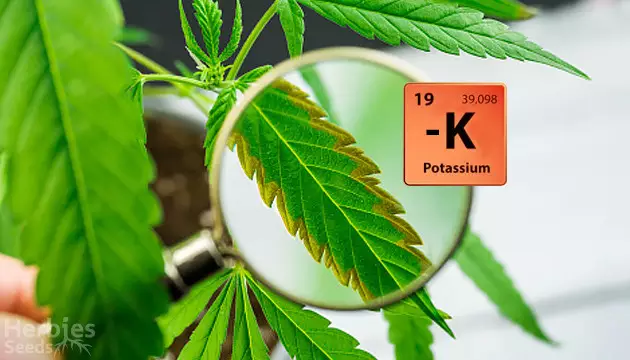
Potassium, one of the three macronutrients most important to a plant’s growth, is necessary for the flowering stage of cannabis and bud development. If you’re seeing weird discolorations and stunted growth in your marijuana garden, potassium deficiency might be responsible. Without a fix, potassium deficiency can quickly ruin months of hard work in your garden. Don’t let this happen – gain all the knowledge you need to successfully combat potassium deficiency from this article.
What Functions Does Potassium Provide For Cannabis Plants?
Potassium’s key function in marijuana plants is transporting water throughout its vascular system. Specifically, potassium regulates water respiration, photosynthesis, stem and branch strength, and disease response. It also affects root health and provides insulation against cold temperatures. As a result, this nutrient has a significant role to play in a plant’s overall health, and potassium deficiency can cause multiple systems and processes to break down across an entire weed plant. Additionally, cannabis plants may absorb too much potassium – a nutrient problem called toxicity. If a cannabis plant is suffering from potassium toxicity, it will have trouble absorbing other nutrients like calcium, zinc and iron.
Potassium Deficiency – Consequences
If left untreated, potassium deficiency can kill a plant. Plants will begin to dry out as it becomes impossible for them to move water. Additionally, cannabis plants with potassium deficiency won’t be able to perform photosynthesis, so they’ll have trouble absorbing light and converting it into energy needed for growth and bud development. Because the organelles that perform photosynthesis, known as chloroplasts, give plants their green color, potassium deficiency will also turn the plants sickly yellow and then deadly brown.
Signs And Symptoms Of Potassium Deficiency
There are generally two places to spot potassium deficiency in cannabis plants. First, you may find evidence on the leaves of your plants. However, you may also find evidence somewhere else in the plant’s body. Let’s learn the details.
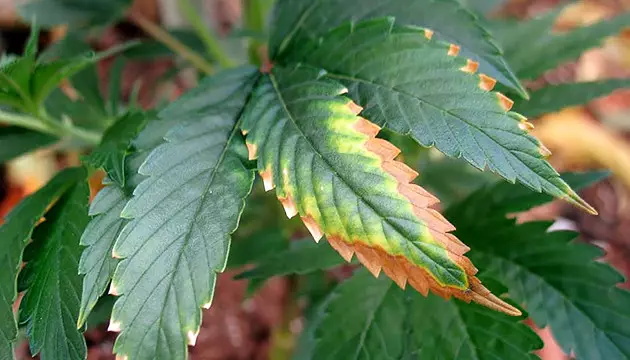
In Leaves
If your garden is potassium-deficient, you’ll typically notice it first in your plants’ leaves. First, the tips and edges of your leaves will appear yellow before progressing to brown. Next, dead brown spots will begin popping up on the surface of your leaves. Unlike most other deficiencies, the veins on your leaves will stay green – this is one surefire way to spot advanced marijuana potassium deficiency.
In Other Parts Of The Plant – Stalks, Stems And Buds
Potassium deficiency can develop and move very quickly throughout a plant. One of the most common symptoms of potassium deficiency you’ll notice in plant structures other than leaves is non-uniform stretching in stalks and stems. Don’t mistake stretching out for growing, though. Plant structures, like buds and leaves, will appear stunted and uneven. You also might notice red stripes developing along the stems of your plants.
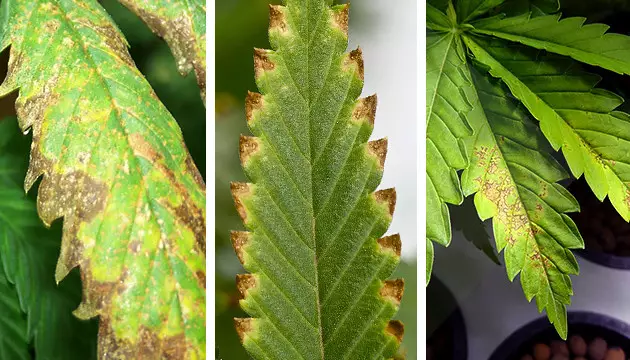
| Potassium Deficiency | Nutrient burn | Calcium deficiency |
Other Problems Commonly Mistaken For Potassium Deficiency
Before you start normalizing potassium levels, you need to make sure you’ve identified the problem correctly. First, it’s easy to mistake nutrient burn for potassium deficiency. Both involve yellowing along the tips of each fan leaf. Leaf tips will also curl upward in both cases. However, plants with nutrient burn won’t develop necrotic brown and yellow spots inside their leaves. In contrast, spotting does also happen with calcium deficiency. Calcium-deficient plants don’t develop yellowing and curling on their tips, though.
Potassium Deficiency – How To Solve It
Like most nutrient problems, growers have found multiple solutions for how to fix potassium deficiency in plants. In general, most potassium deficiencies are caused by one of two culprits: pH issues and low-grade nutrients. Luckily, both of these are easy to fix if you act quickly.
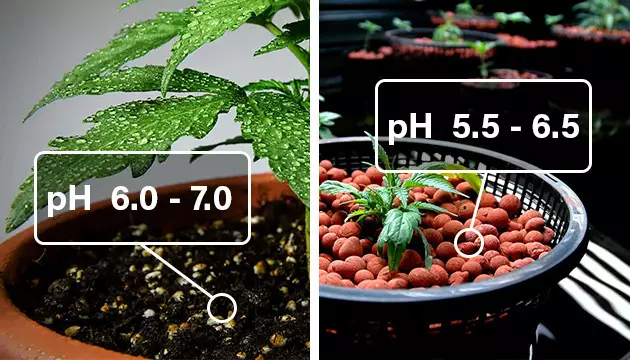
Adjust pH
If the pH of your media isn’t within the correct range, your plants won’t be able to uptake the nutrients they need. Potassium is no exception. The ideal pH for plants to uptake potassium in soil grows is between 6.0 and 7.0. Hydroponic systems and other media like coco coir need a pH between 5.5 and 6.5. You can reset the pH of your media by flushing your plants with water set to the correct pH.
Change Your Nutrient Mix
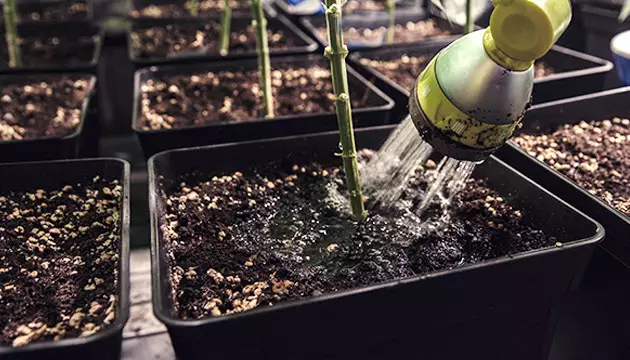
Did you know that if a plant has too much of one nutrient, it can prevent it from absorbing another? For example, too much calcium or nitrogen in your mix can inhibit potassium absorption. This is called “locking out.” As a result, if you’re seeing potassium deficiency, there may be other nutrients locking out potassium uptake. Flush your plants and adjust your nutrient regiment accordingly.
Potassium Deficiency Prevention
If you’re a newer grower, in order to never be bothered by potassium deficiency, you may want to invest in one company’s line of nutrients. Fertilizer companies have specially-made formulas to prevent issues like potassium deficiency from ever arising. Remember that potassium deficiency during flowering is much more dangerous than during vegetation. It can lead to small, stunted buds and inhibited terpene development, so your plants won’t have any smell or taste.
Keep Your Plants Healthy!
Armed with a solid idea of how potassium functions in a cannabis plant, you’re now ready to assess and address any deficiency of potassium in your garden. Every grow is a complex system that has nearly countless variables affecting it at any given moment. Potassium deficiency is just one of these issues. However, using our guide, you’ll be able to identify and solve potassium deficiency whenever it rears its ugly head. Good luck!
Herbies Head Shop expressly refuses to support the use, production, or supply of illegal substances. For more details read our Legal Disclaimer.
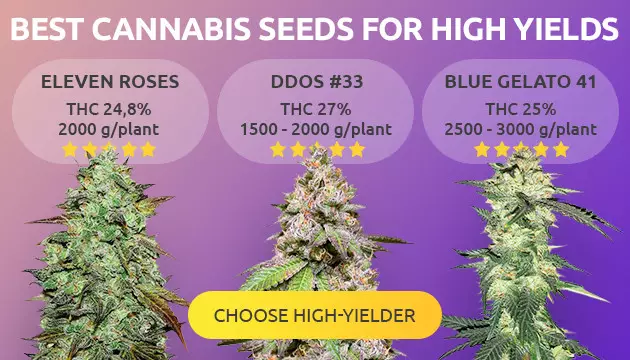
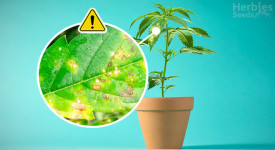


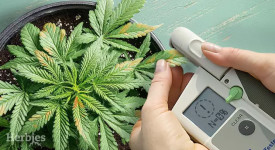
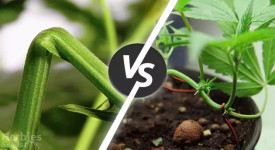

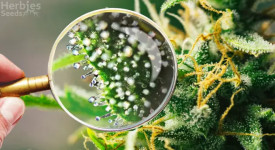
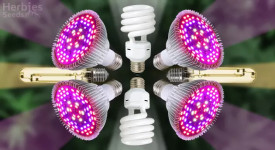



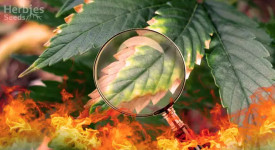
Thank you for leaving a comment for us!
Your feedback will be posted shortly after our moderator checks it.
Please note that we don’t publish reviews that: